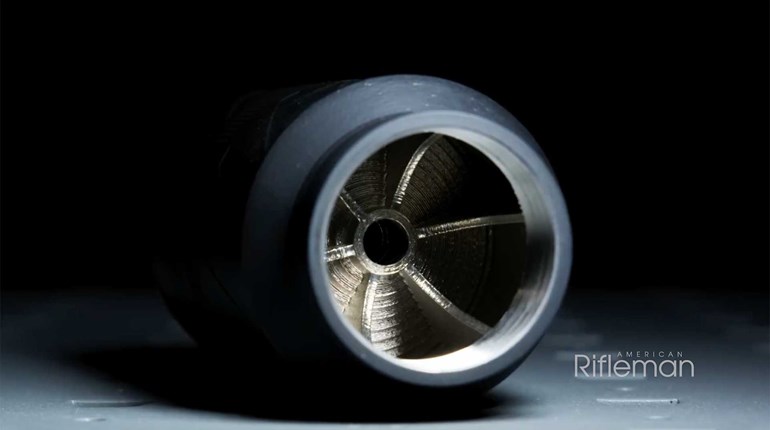
You could be forgiven if you thought the semi-automatic rifle world began and ended with the AR-15. It does not, and a case in point is the new IWI Carmel. Yes, it uses AR-15 magazines (it would be stupid not to, and the folks at IWI are not stupid), and other accessories, but the rest isn’t AR-ish at all.
Inside are some expected details: the barrel is cold-hammer forged, and has a twist rate of 1:7-inches, the accepted modern norms. The bore is chrome lined and chambered in 5.56 NATO. Unlike the AR, the Carmel uses a short-stroke-piston system, and as part of that system, the gas block is also a gas regulator, allowing you to dial down the gas flow for use when suppressed.

The upper receiver is the firearm, and there is a serial number on the plate inset into the receiver on the left side. The upper is an assemblage of aluminum and polymer, with the main receiver in which the bolt and carrier reside being polymer, and the handguard is made of aluminum. The handguard and its contiguous Picatinny rail are assembled to the polymer receiver by means of six hex-socket screws. These are not user-serviceable, so they should be left alone.
On the right side, the ejection port has a spring-loaded, ejection-port door, one that latches shut when pressed closed, but stays open once the reciprocating bolt has opened it. Behind the ejection port is a raised polymer deflector, which rebounds the extracted brass forward at an angle.
At the upper-rear corner of the receiver, on both sides, there are QD-sling-swivel sockets. The stock has steel loops for clipping on a sling. For the front mounting point, the Carmel came with an M-Lok QD sling adapter, to be installed where you need or wish it to be.
A full-length Picatinny rail adorns the upper receiver for mounting optics, iron sights and other accessories, while the fore-end has M-Lok slots at 3, 6 and 9 o’clock for attaching yet more extras. The fore-end is relieved at the gas block, so you have access to the piston adjustment, provided you don’t attach a light or laser there, which would block the opening.
The B5 Systems pistol grip uses the same attachment method and mount as you’d find on an AR-15, so if is not to your taste, you can swap it for one that is more to your liking. That said, this B5 unit is excellent. The safety/selector is nestled underneath an angled shoulder to protect it from being moved by rubbing on your gear.
Controls are fully ambidextrous. The safety/selector, magazine release and bolt hold-open have controls on both sides of the receivers. The non-reciprocating charging handle is in front of the chamber, below the top rail, and while it only has a tab for one side, it can be switched to either. I suppose that’s not technically fully ambidextrous, but certainly user-selective as to which side it is on.
The stock is an interesting bit of design and engineering. It folds, which means the internal parts cannot be those of a standard AR-15, as there is no buffer tube. In addition to folding, it is adjustable for length, and has an adjustable cheekpiece so you can set it up so you have a comfortable cheek weld for the optics you are using. The buttplate is a non-slip rubber pad, more to keep the stock from shifting than to absorb any recoil the 5.56 NATO might generate. The length-of-pull has six positions, and the latch is a tab inside of the triangular opening ahead of the buttplate. Grab the buttplate by putting a finger or fingers through the triangle, squeeze and the button unlatches the stock. Pull or push to the desired length, let go and let it snap into locked position. The stock folds at all lengths-of-pull.

In handling, the Carmel seems a bit, well, bulky. To be fair, of late I’ve been handling tuned and near-custom ARs that have been set up to be as sleek and compact as possible, so that aspect is definitely a personal-experience matter. What is not a drawback, however, is the trigger, which right out of the box was better than any non-custom trigger in any AR-15 I’ve handled for a long time. The adjustable stock was well-fitting once I had figured out the controls. As a tall skinny guy, I find a lot of stocks to be too short, and the “cheek weld” many stock designs offer to be insufficient. The Carmel did not disappoint. It also did not disappoint as far as accuracy was concerned. I mounted a Leupold Mark 4 3-9x36 mm MR/T on top—it and the trigger made shooting small groups at 100 yards an easy task.
In testing, the recoil was soft, which is due to two factors: One, the Carmel starts out life at more than 8 pounds. By the time I had the optics mounted and a loaded magazine inserted, it was more than 9 pounds. A 9-pound 5.56 NATO rifle is not going to recoil with much authority. Also, it ships with a muzzle brake installed that is quite effective, pretty much eliminating any recoil the weight didn’t dissipate, and worked well enough that I’d be tempted to swap it onto a competition rifle. I did not test the gas system for use when suppressed, because I would have had to remove that muzzle brake, and I didn’t want the temptation of the brake being handy to lure me into sending the Carmel back lacking some parts. (Yes, the brake is that good.)
Because it takes standard AR-15 magazines, you have the full array of modern magazines available to you, not just USGI aluminum ones. The Carmel did not fail to fire, extract, eject or lock open after the last round had been fired with the included Magpul PMag Gen 3 or any other unit I tried in the carbine. Furthermore, magazines are easily inserted and drop free of their own weight when the magazine-release paddle is depressed.

Now, the Carmel, while being a very soft-shooting rifle, did not come without some minor problems. It seems the Carmel needed just a bit more fine-tuning—not in its function, but rather to be ergonomic, at least for American expectations. The fore-end is good looking, and serves its purpose well, but it could be slimmer. It must be as tall as it is to fit the piston system inside, but it doesn’t have to be as deep or wide. Slimmer is better, here. The stock latch requires your full hand force to unlatch the stock for folding. Simply pressing in the tab won’t do it; you have to really lean on it. Similarly, when it comes time to unfold the stock and latch it in place, do not be gentle. You needn’t abuse it, but you will have to swing the stock around with some authority or it simply won’t latch. The first few times you try to lock the stock in place, you will probably find you weren’t forceful enough. While the stock is folded, the latch tab, a sharp-edged and sharp-cornered piece of steel, sits at the outside edge of the stock where it meets the receiver when closed, standing ready to gouge your hands or your gear. You must be careful or it will bite you, and it is indeed a sharp piece of steel.
 The cheekpiece does not angle up like other designs, but lifts straight up. To move it, you have to squeeze the latch on both sides of the cheekpiece. Pressing just one side won’t do, and while it has four settings, it only has those four. If none are just right for you, you’ll have to settle for “close enough.” Lastly, when folded, the Carmel is a rather thick package. But to be fair, no folding-stock rifle actually folds down to be svelte.
The cheekpiece does not angle up like other designs, but lifts straight up. To move it, you have to squeeze the latch on both sides of the cheekpiece. Pressing just one side won’t do, and while it has four settings, it only has those four. If none are just right for you, you’ll have to settle for “close enough.” Lastly, when folded, the Carmel is a rather thick package. But to be fair, no folding-stock rifle actually folds down to be svelte.
Disassembly is easy and quite unlike that of the AR. Unload and check clear. Press the stock folding latch, hinge the stock folded and leave it folded. On the rear plate of the upper, you’ll see a button. Press it—again, this needs some force—and then pull the stock-latch clip out to the left side of the receiver. You can now use the charging handle to pop the plate open and extract all the upper internals as one assembly. That’s it, unless you really need to clean the trigger assembly. In that case, press the rear takedown pin (there is no forward one) out from right to left and hinge the assembly down, off of the upper receiver. Like the rest of the adjustments or disassembly, the pin will require some force to make it move. If you want to change sides for the charging handle, now is the time. With the bolt-carrier assembly out of the upper receiver, slide the charging handle back to the larger opening of its travel slot, and then simply push the handle through to the other side.
Once you have scrubbed and lubricated the internals, catch the front lip of the trigger housing on the upper, hinge it up and then press the takedown pin across. Insert the bolt-carrier assembly into the upper and press forward. Press the plate in at the button, and then shove the stock-hinge catch back into place.
As of the writing of this article, there is a safety recall on the Carmel, so if you already own one, visit iwi.us to get the details you need to get yours upgraded. I encountered no issues with my rifle, but it is better to be safe than sorry, so this one must go back for the fix, much to my chagrin.
The list price of the Carmel is a dollar less than $1,800. Is it worth it? I think so. The price is in the ballpark for many big-name AR-15s, less than many semi-custom ones, and none of those offer a folding stock. The trigger is superb, the felt recoil soft and the accuracy excellent for everything but a 5.56 NATO-equivalent, PRS-series competition rifle. All I can suggest as the acid test is for you to get down to your local gun shop and handle one. If it is to your liking, you will have an excellent choice to let you stand out from the legions of AR-15s at your local range and confidently defend yourself.
 Nightstick LGL-170A Long Gun Light Kit
Nightstick LGL-170A Long Gun Light Kit
If you intend to use the IWI Carmel or any other long gun for home defense, having a weapon-mounted light is a good idea. Since the firearm in question will require two hands to operate, relying on a handheld flashlight to identify friend from foe in the dark is not a great option. Enter Nightstick, a lighting company based in Texas that has been serving the law enforcement market for decades. Its LGL-170A Long Gun Light Kit includes a powerful, 1500-lumen light with an integral rail mount, a tailcap switch, a remote pressure switch with a 6-inch cable and mount, a 45-degree offset mount and a wire-management clamp. The light is powered by an included rechargeable lithium-ion battery and has both momentary and constant-on modes. It can also run on two CR123 batteries should you prefer. Made from aircraft-grade 6061-T6 aluminum, it is a tough, durable unit that is also IP-X7 waterproof rated, making it an excellent choice for any defensive task. MSRP: $255.30; nightstick.com




































